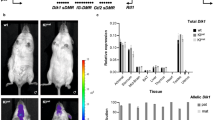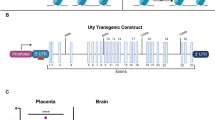Abstract
Recently, genome-wide association studies have implicated the human LIN28B locus in regulating height and the timing of menarche1,2,3,4,5. LIN28B and its homolog LIN28A are functionally redundant RNA-binding proteins that block biogenesis of let-7 microRNAs6,7,8,9. lin-28 and let-7 were discovered in Caenorhabditis elegans as heterochronic regulators of larval and vulval development but have recently been implicated in cancer, stem cell aging and pluripotency10,11,12,13. The let-7 targets Myc, Kras, Igf2bp1 and Hmga2 are known regulators of mammalian body size and metabolism14,15,16,17,18. To explore the function of the Lin28–Let-7 pathway in vivo, we engineered transgenic mice to express Lin28a and observed in them increased body size, crown-rump length and delayed onset of puberty. Investigation of metabolic and endocrine mechanisms of overgrowth in these transgenic mice revealed increased glucose metabolism and insulin sensitivity. Here we report a mouse that models the human phenotypes associated with genetic variation in the Lin28–Let-7 pathway.
This is a preview of subscription content, access via your institution
Access options
Subscribe to this journal
Receive 12 print issues and online access
$209.00 per year
only $17.42 per issue
Buy this article
- Purchase on Springer Link
- Instant access to full article PDF
Prices may be subject to local taxes which are calculated during checkout




Similar content being viewed by others
Accession codes
Accessions
Gene Expression Omnibus
NCBI Reference Sequence
Change history
13 June 2010
In the version of this article initially published online, the authors failed to acknowledge the source of the unpublished Lin28a knockout mouse strain. These mice were provided by Eric Moss at The University of Medicine and Dentistry of New Jersey and will be described in a separate report (S.R.V., G.S., H.Z., W.S.E., G.C. Heffner et al., unpublished data). The error has been corrected for the print, PDF and HTML versions of this article.
References
Lettre, G. et al. Identification of ten loci associated with height highlights new biological pathways in human growth. Nat. Genet. 40, 584–591 (2008).
Ong, K.K. et al. Genetic variation in LIN28B is associated with the timing of puberty. Nat. Genet. 41, 729–733 (2009).
Sulem, P. et al. Genome-wide association study identifies sequence variants on 6q21 associated with age at menarche. Nat. Genet. 41, 734–738 (2009).
He, C. et al. Genome-wide association studies identify loci associated with age at menarche and age at natural menopause. Nat. Genet. 41, 724–728 (2009).
Perry, J.R.B. et al. Meta-analysis of genome-wide association data identifies two loci influencing age at menarche. Nat. Genet. 41, 648–650 (2009).
Viswanathan, S.R., Daley, G.Q. & Gregory, R.I. Selective blockade of microRNA processing by Lin28. Science 320, 97–100 (2008).
Newman, M.A., Thomson, J.M. & Hammond, S.M. Lin-28 interaction with the Let-7 precursor loop mediates regulated microRNA processing. RNA 14, 1539–1549 (2008).
Chang, T.C. et al. Lin-28B transactivation is necessary for Myc-mediated let-7 repression and proliferation. Proc. Natl. Acad. Sci. USA 106, 3384–3389 (2009).
Dangi-Garimella, S. et al. Raf kinase inhibitory protein suppresses a metastasis signalling cascade involving LIN28 and let-7. EMBO J. 28, 347–358 (2009).
Viswanathan, S.R. et al. Lin28 promotes transformation and is associated with advanced human malignancies. Nat. Genet. 41, 843–848 (2009).
Nishino, J., Kim, I., Chada, K. & Morrison, S.J. Hmga2 promotes neural stem cell self-renewal in young but not old mice by reducing p16Ink4a and p19Arf expression. Cell 135, 227–239 (2008).
Yu, F. et al. let-7 regulates self renewal and tumorigenicity of breast cancer cells. Cell 131, 1109–1123 (2007).
Yu, J. et al. Induced pluripotent stem cell lines derived from human somatic cells. Science 318, 1917–1920 (2007).
Trumpp, A. et al. c-Myc regulates mammalian body size by controlling cell number but not cell size. Nature 414, 768–773 (2001).
Weedon, M.N. et al. A common variant of HMGA2 is associated with adult and childhood height in the general population. Nat. Genet. 39, 1245–1250 (2007).
Christiansen, J. et al. IGF2 mRNA-binding protein 2: biological function and putative role in type 2 diabetes. J. Mol. Endocrinol. 43, 187–195 (2009).
Hansen, T.V. et al. Dwarfism and impaired gut development in insulin-like growth factor II mRNA-binding protein 1-deficient mice. Mol. Cell. Biol. 24, 4448–4464 (2004).
Zhou, X. et al. Mutation responsible for the mouse pygmy phenotype in the developmentally regulated factor HMGI-C. Nature 376, 771–774 (1995).
Hochedlinger, K. et al. Ectopic expression of Oct-4 blocks progenitor-cell differentiation and causes dysplasia in epithelial tissues. Cell 121, 465–477 (2005).
Krewson, T.D. et al. Chromosomes 6 and 13 harbor genes that regulate pubertal timing in mouse chromosome substitution strains. Endocrinology 145, 4447–4451 (2004).
Yang, D.H. & Moss, E.G. Temporally regulated expression of Lin-28 in diverse tissues of the developing mouse. Gene Expr. Patterns 3, 719–726 (2003).
Polesskaya, A. et al. Lin-28 binds IGF-2 mRNA and participates in skeletal myogenesis by increasing translation efficiency. Genes Dev. 21, 1125–1138 (2007).
Sun, F.L. et al. Transactivation of Igf2 in a mouse model of Beckwith-Wiedemann syndrome. Nature 389, 809–815 (1997).
Elliott, M. et al. Clinical features and natural history of Beckwith-Wiedemann syndrome: presentation of 74 new cases. Clin. Genet. 46, 168–174 (1994).
Subramanian, A. et al. Gene set enrichment analysis: a knowledge-based approach for interpreting genome-wide expression profiles. Proc. Natl. Acad. Sci. USA 102, 15545–15550 (2005).
Mootha, V.K. et al. PGC-1α-responsive genes involved in oxidative phosphorylation are coordinately downregulated in human diabetes. Nat. Genet. 34, 267–273 (2003).
Christofk, H.R. et al. The M2 splice isoform of pyruvate kinase is important for cancer metabolism and tumour growth. Nature 452, 230–233 (2008).
Clower, C.V. et al. The alternative splicing repressors hnRNP A1/A2 and PTB influence pyruvate kinase isoform expression and cell metabolism. Proc. Natl. Acad. Sci. USA 107, 1894–1899 (2010).
Weedon, M.N. et al. Genome-wide association analysis identifies 20 loci that influence adult height. Nat. Genet. 40, 575–583 (2008).
Moss, E.G., Lee, R.C. & Ambros, V. The cold shock domain protein LIN-28 controls developmental timing in C. elegans and is regulated by the lin-4 RNA. Cell 88, 637–646 (1997).
Nimmo, R.A. & Slack, F.J. An elegant miRror: microRNAs in stem cells, developmental timing and cancer. Chromosoma 118, 405–418 (2009).
Abbott, A.L. et al. The let-7 microRNA family members mir-48, mir-84, and mir-241 function together to regulate developmental timing in Caenorhabditis elegans. Dev. Cell 9, 403–414 (2005).
Biro, F.M. et al. Impact of timing of pubertal maturation on growth in black and white female adolescents: The National Heart, Lung, and Blood Institute Growth and Health Study. J. Pediatr. 138, 636–643 (2001).
Yun, J. et al. Glucose deprivation contributes to the development of KRAS pathway mutations in tumor cells. Science 325, 1555–1559 (2009).
Gao, P. et al. c-Myc suppression of miR-23a/b enhances mitochondrial glutaminase expression and glutamine metabolism. Nature 458, 762–765 (2009).
Vander Heiden, M.G., Cantley, L.C. & Thompson, C.B. Understanding the Warburg effect: the metabolic requirements of cell proliferation. Science 324, 1029–1033 (2009).
Berti, L. & Gammeltoft, S. Leptin stimulates glucose uptake in C2C12 muscle cells by activation of ERK2. Mol. Cell. Endocrinol. 157, 121–130 (1999).
Nathan, B.M., Hodges, C.A. & Palmert, M.R. The use of mouse chromosome substitution strains to investigate the genetic regulation of pubertal timing. Mol. Cell. Endocrinol. 254–255, 103–108 (2006).
Nathan, B.M. et al. A quantitative trait locus on chromosome 6 regulates the onset of puberty in mice. Endocrinology 147, 5132–5138 (2006).
Mettus, R.V. & Rane, S.G. Characterization of the abnormal pancreatic development, reduced growth and infertility in Cdk4 mutant mice. Oncogene 22, 8413–8421 (2003).
Acknowledgements
Lin28a knockout mice were generously provided by Eric Moss at The University of Medicine and Dentistry of New Jersey and will be described separately (S.R.V., G.S., H.Z., W.S.E., G.C. Heffner et al., unpublished data). We acknowledge J. Powers, H. Rajagopalan and M. Kharas for invaluable discussions and advice regarding this work. We also thank Y.-H. Loh, M. White, L. Wang and J. Majzoub for in-depth discussion and endocrine expertise. This work was supported by a Graduate Training in Cancer Research Grant (5 T32 CA09172-35) to H.Z., a NIH grant (R01HD048960) to M.R.P., a NIH Directors Pioneer Award and a HHMI grant to G.Q.D.
Author information
Authors and Affiliations
Contributions
H.Z. and G.Q.D. conceived the experiments and wrote the manuscript. H.Z. performed all experiments unless otherwise indicated. S.S. contributed to the work in Figures 1, 2 and 4 and Supplementary Figures 4 and 5. N.S.-C. performed the GSEA microarray analysis and created Figure 4j–l. G.S. generated the data in Supplementary Figure 1a,b. W.S.E. performed mouse husbandry, genotyping and experiments shown in Supplementary Figure 3d. S.R.V. made the Lin28a mouse ES cell line and mouse strain. A.T. performed the mouse chimera injections for the generation of all the transgenic strains. C.G. provided experimental assistance for puberty phenotyping and isolation and processing of endocrine organs. J.L.R., M.F.L., J.N.H. and M.R.P. contributed reagents, analyzed data and edited the manuscript.
Corresponding author
Ethics declarations
Competing interests
The authors declare no competing financial interests.
Supplementary information
Supplementary Text and Figures
Supplementary Figures 1–5 (PDF 3260 kb)
Rights and permissions
About this article
Cite this article
Zhu, H., Shah, S., Shyh-Chang, N. et al. Lin28a transgenic mice manifest size and puberty phenotypes identified in human genetic association studies. Nat Genet 42, 626–630 (2010). https://doi.org/10.1038/ng.593
Received:
Accepted:
Published:
Issue Date:
DOI: https://doi.org/10.1038/ng.593
This article is cited by
-
Dynamic chromatin architectures provide insights into the genetics of cattle myogenesis
Journal of Animal Science and Biotechnology (2023)
-
A DEAD-box helicase drives the partitioning of a pro-differentiation NAB protein into nuclear foci
Nature Communications (2023)
-
Lin28a maintains a subset of adult muscle stem cells in an embryonic-like state
Cell Research (2023)
-
Pharmacological inhibition of Lin28 promotes ketogenesis and restores lipid homeostasis in models of non-alcoholic fatty liver disease
Nature Communications (2022)
-
Altered Gut Microbiota Profile in Lin28a Transgenic Mice Can Improve Glucose Tolerance
Bulletin of Experimental Biology and Medicine (2021)



